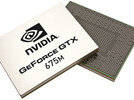NVIDIA GeForce GTX 675M SLI vs NVIDIA GeForce GTX 680MX
NVIDIA GeForce GTX 675M SLI
► remove from comparison
The NVIDIA GeForce GTX 675M SLI is a high-end graphics solution for laptops based on the two GTX 675M graphic cards in SLI mode. With SLI, each card usually renders a single frame (AFR mode). Therefore, it may suffer from micro stuttering in low fps ranges of 30fps. This happens because of different timespans between two frames (e.g., irregular delays between sequential frames).
The GeForce GTX 675M SLI supports the same features as a single GTX 675M card. Therefore, it supports DirectX 11 and is produced in a 40nm fabrication process at TSMC. Technically, the GTX 675M (SLI) is completely identical to the GTX 580M (SLI).
GF114 architecture
The GF114 core is a power-optimized version of the GF104 (used in the GTX 485M), but with no architectural changes. Therefore, the performance per MHz stays the same. Nvidia, however, was able to clock the shaders higher while still remaining in the same power envelope. The GTX 675M offers all 384 shader cores in the GF114. More information on the similar GF104 architecture can be found on the GeForce GTX 485M page.
Performance
Due to the higher clock speeds, the GeForce GTX 675M SLI is faster than the GTX 485M SLI an as fast as the GTX 580M SLI. Demanding games like Crysis 2, Witcher 2, Dirt 3 or even Metro 2033 can be played in 1920x1080 with maximum details and most Antialiasing features enabled.
Features
Similar to the older GF104 chip, the GF114 also supports Bitstream HD Audio (Blu-Ray) output via HDMI. That means it can transfer, for example, Dolby True HD or DTS-HD bitstream without quality loss to a HiFi receiver.
The GTX 675M offers the PureVideo HD technology for video decoding. The included Video Processor 4 (VP4) supports feature set C and is therefore able to fully decode MPEG-1, MPEG-2, MPEG-4 Part 2 (MPEG-4 ASP - e.g., DivX or Xvid), VC-1/WMV9, and H.264 (VLD, IDCT, Motion Compensation, and Deblocking).
Furthermore, the GPU is able to decode two 1080p streams simultaneously (e.g. for Blu-Ray Picture-in-Picture).
Through CUDA, OpenCL, and DirectCompute 2.1 support, the GeForce GTX 675M can be of help in general calculations. For example, the stream processor can encode videos considerably faster than can a fast CPU. Furthermore, physics calculations can be done by the GPU using PhysX (e.g., supported by Mafia 2 or Metro 2033). As two 675M are used for the SLI combination, one card alone can be used for PhysX and the other for rendering the game graphics.
3D Vision enables the laptop to send 3D content (3D games, 3D Web Streaming, 3D photos, 3D Blu-Rays) to a built-in 3D enabled screen or an external 3D TV (only if supported by the laptop manufacturer).
The power consumption of the GeForce GTX 675M is in the same region as the old GTX 580M, which is supposedly about 100 Watt (TDP including the MXM board and memory). Therefore, the SLI system needs up to 200 Watt using both cards. Without load, the performance is clocked at 50/100 MHz (chip/shader) in 2D mode and 200/400 in 3D mode to save power. Furthermore, a single card can be deactivated to save power.
The similar desktop GeForce GTX 580 is based on the GF110 chip and much faster in comparison. Therefore, the 675M is more closely related to the GeForce GTX 560Ti, the latter of which is still faster due to higher clock speeds.
NVIDIA GeForce GTX 680MX
► remove from comparison
The NVIDIA GeForce GTX 680MX is a high-end DirectX 11-compatible graphics card commonly found on Apple iMac products. It is based on the 28nm GK104 Kepler architecture similar to the GTX 680M, but features more CUDA cores (1536 vs. 1344) and a higher memory clock rate (720/2500MHz vs. 720/1800MHz)
Architecture
The Kepler architecture is the successor to the Fermi architecture that first appeared in laptops with the GeForce 400M series. The GK104 Kepler core offers eight shader blocks, called SMX, that are clocked at the same speed as the central core. In the GTX 680MX, all eight blocks are active for a total of 1536 CUDA cores. Although the Kepler architecture can utilize more shader cores than a Fermi chip, its shaders can be up to twice as power efficient. However, due to the missing hot clock of the shader domain, two shaders of a Kepler chip are of similar speed to one shader of a Fermi chip (as the latter is clocked twice as fast).
PCIe 3.0 is now supported by the mobile Kepler series and an optional Turbo mode can automatically overclock the Nvidia card by a theoretical 15 percent if the laptop cooling system allows it. The implementation of this boost mode is done in the BIOS, but it is ultimately dependent upon the manufacturer of the laptop.
Performance
Thanks to the additional shader cores and the faster memory, the graphics performance of the GeForce GTX 680MX should be 15 - 25 percent above the GTX 680M and similar to the Desktop GTX 580. The GPU has enough power to run demanding games of 2012 fluently with Full HD resolution and maxed out graphical settings. Battlefield 3, Skyrim, and Crysis 2, for example, are playable at the highest detail settings.
As an example, the GTX 680MX can play Battlefield 3 on ultra settings at 30 FPS on a native resolution of 2560x1440 during our benchmark sequence. For fluent multiplayer gameplay, the resolution and/or anti-aliasing should be reduced (e.g. 1920x1080 Ultra at 45 fps).
Features
The improved feature set now includes support for up to 4 active displays. Furthermore, high resolution monitors of up to 3840x2160 pixels can now be connected using DisplayPort 1.2 or HDMI 1.4a if available. HD-Audio codecs, such as Dolby TrueHD and DTS-HD, can be transmitted via bitstream mode through the HDMI port. However, as most laptops will feature Optimus, the integrated GPU will likely have direct control over the display ports and may limit the feature set available by the Nvidia Kepler cards.
The 5th generation PureVideo HD video processor (VP5) is also integrated in the GK104 core and offers hardware decoding of HD videos. Common codecs such as MPEG-1/2, MPEG-4 ASP, H.264 and VC1/WMV9 are fully supported up to 4K resolutions while VC1 and MPEG-4 are supported up to 1080p. Two streams can be decoded in parallel for features such as Picture-in-Picture. Another novelty is the inclusion of a dedicated video encoding engine similar to Intel QuickSync that can be accessed by the NVENC API.
The power consumption of the GeForce GTX 680MX should be somewhat higher than the GTX 680M, making it difficult to cool for laptops. The Apple iMac is currently the most readily available product to utilize this high-end card.
| NVIDIA GeForce GTX 675M SLI | NVIDIA GeForce GTX 680MX | |||||||||||||||||||||||||||||||||||||||||||||||||||||||||||||
| GeForce GTX 600M Series |
|
| ||||||||||||||||||||||||||||||||||||||||||||||||||||||||||||
| Codename | N12E-GTX2 | |||||||||||||||||||||||||||||||||||||||||||||||||||||||||||||
| Architecture | Fermi | Kepler | ||||||||||||||||||||||||||||||||||||||||||||||||||||||||||||
| Pipelines | 768 - unified | 1536 - unified | ||||||||||||||||||||||||||||||||||||||||||||||||||||||||||||
| Core Speed | 620 MHz | 720 MHz | ||||||||||||||||||||||||||||||||||||||||||||||||||||||||||||
| Shader Speed | 1240 MHz | |||||||||||||||||||||||||||||||||||||||||||||||||||||||||||||
| Memory Speed | 3000 MHz | 5000 MHz | ||||||||||||||||||||||||||||||||||||||||||||||||||||||||||||
| Memory Bus Width | 256 Bit | 256 Bit | ||||||||||||||||||||||||||||||||||||||||||||||||||||||||||||
| Memory Type | GDDR5 | GDDR5 | ||||||||||||||||||||||||||||||||||||||||||||||||||||||||||||
| Shared Memory | no | no | ||||||||||||||||||||||||||||||||||||||||||||||||||||||||||||
| API | DirectX 11, Shader 5.0 | DirectX 11, Shader 5.0, OpenGL 4.3 | ||||||||||||||||||||||||||||||||||||||||||||||||||||||||||||
| Power Consumption | 2x 100 Watt | 122 Watt | ||||||||||||||||||||||||||||||||||||||||||||||||||||||||||||
| technology | 40 nm | 28 nm | ||||||||||||||||||||||||||||||||||||||||||||||||||||||||||||
| Features | Optimus, SLI, PhysX, Verde Drivers, CUDA, 3D Vision, 3DTV Play | Optimus, SLI, PhysX, Verde Drivers, CUDA, 3D Vision, 3DTV Play | ||||||||||||||||||||||||||||||||||||||||||||||||||||||||||||
| Notebook Size | large | large | ||||||||||||||||||||||||||||||||||||||||||||||||||||||||||||
| Date of Announcement | 06.01.2011 | 23.10.2012 | ||||||||||||||||||||||||||||||||||||||||||||||||||||||||||||
| Link to Manufacturer Page | www.nvidia.com | www.geforce.com | ||||||||||||||||||||||||||||||||||||||||||||||||||||||||||||
| Max. Amount of Memory | 2048 MB | |||||||||||||||||||||||||||||||||||||||||||||||||||||||||||||
| Transistors | 3.5 Billion |


 Deutsch
Deutsch English
English Español
Español Français
Français Italiano
Italiano Nederlands
Nederlands Polski
Polski Português
Português Русский
Русский Türkçe
Türkçe Svenska
Svenska Chinese
Chinese Magyar
Magyar





